The Wrack Line – Issue 3
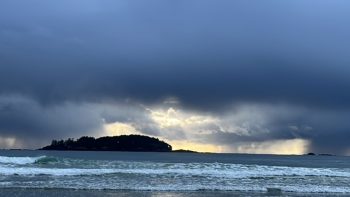
Chesterman Beach, a place I am fortunate to walk several times a week, at its moody best.
A few things that caught my eye and interest lately.
I’ve just returned from the Vancouver Writers Fest, which was fabulous as always. The big draw for me was seeing Rebecca Solnit, an essayist whose writing I find endlessly fascinating. (She’s a master at seamlessly connecting things that, at first glance, seem disparate.) I saw her twice—both times speaking on hope and climate change—and was also re-reading her book, The Faraway Nearby. I often copy out paragraphs I admire, so I filled a lot of pages with her writings. This morning, as I finished and read the bonus story that ran along the bottom of each page in The Faraway Nearby, she taught me a new word—lachryphagy, the drinking of tears—which led me to Scientists Say weekly word. Yay for interesting rabbit holes.
Check out these fabulous works of art created by Duke Riley from marine plastic. I especially love the reimagined scrimshaw on jugs.
Also at the Writers Fest I saw Lauren Groff, author of Matrix, which I’ve read, and The Vaster Wilds, which I haven’t. (Yet; it’s on the list.) She was a delight and it was great to read about her process, which is detailed in this New York Times article. (In short, she writes multiple complete drafts in longhand, then puts them in a box and never looks at them again, but the ideas and characters “start to take on gravity and density.”)
I’ve recently left my fulltime job as an editor at Hakai Magazine, to return to freelancing. I adored that job and my colleagues, and learned so much, but I’m ready to pursue some of my own writing and just have more flexibility in my days. As I am entering what some call the third stage of life—my “third act” let’s say—I find myself particularly drawn to older artists who are showing they still have lots to offer, damn it! Finding Margaret Fabrizio, a very spunky 90-something-year-old fabric artist and her kawandi quilts, was a nice surprise. I highly recommend following her Instagram feed. She’s a character and a half.
Speaking of phases of life, and of the ways we mark time over the year, I love the idea that there are more than four seasons. Maybe there are six? Or 72 microseasons, such as “peonies bloom” or “worms surface?” And the Nuu-chah-nulth people, in whose land I live, mark time by months: earth washing moon or geese in formation moon or spring salmon moon.
Rats: not all bad and endlessly fascinating, especially in the capable hands of JB MacKinnon, with bonus art by Sarah Gilman.
I didn’t have a lot of time to write while I was at Hakai Magazine, but I am happy that I got to write a profile of Robert Higgins, a man obsessed by meiofauna, the stuff that lives between the grains of sand. Bob died last December, but his work and the scientists he inspired live on.
Thanks to a post on Rob Walker’s Substack, The Art of Noticing, (also the title of his great book), I was introduced to P. Jean Oliver, an artist and writer who doesn’t live too far from me. Be like a crow, indeed.
Whales to the Rescue in the Land of Enchantment
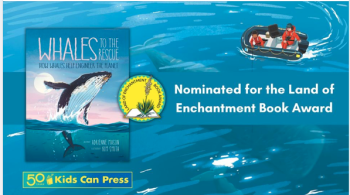 I received some nice news this week. Whales to the Rescue has been short-listed for the Land of Enchantment Book Award. Organized by the New Mexico Library Association and the New Mexico Literacy Association, this is an award in which children read from a list of books and vote for their favourite. The results won’t be out until 2024, but it’s nice to know my book will be on the bookshelves and bedside tables of some young people this year.
I received some nice news this week. Whales to the Rescue has been short-listed for the Land of Enchantment Book Award. Organized by the New Mexico Library Association and the New Mexico Literacy Association, this is an award in which children read from a list of books and vote for their favourite. The results won’t be out until 2024, but it’s nice to know my book will be on the bookshelves and bedside tables of some young people this year.
The Wrack Line – Issue 2
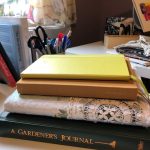 Happy new year! Here are a few things that caught my eye.
Happy new year! Here are a few things that caught my eye.
I subscribe to a fair number of newsletters, but I’ve been trying to hone the list. I did add one though and I’m not sorry. Noted, by Jillian Hess with the apt tag line: “tips & tricks from the world’s best note takers.” Love. Here’s a recent post: 12 Ways to Use a Diary. So good.
I have a, um, complicated relationship with journals. I keep them, but I can’t seem to come up with the right one. Thus, I have many. (As evidenced in the office clean I did over the holiday, where I tried to cram them all in three bankers boxes, but there’s still enough for a fourth.) Here is my current journal “turducken” (to lift from Austin Kleon, whose newsletter I also subscribe to and you must as well), from the bottom up:
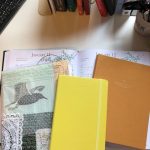 1. A Gardeners Journal from Lee Valley (it’s a 10-year journal, to record weather, what’s in bloom, etc. and a recent birthday give to me from a dear friend; I like the idea of tracking the weather and what I was doing in the garden over time. 11 days down, 3,639 to go before it’s filled!).
1. A Gardeners Journal from Lee Valley (it’s a 10-year journal, to record weather, what’s in bloom, etc. and a recent birthday give to me from a dear friend; I like the idea of tracking the weather and what I was doing in the garden over time. 11 days down, 3,639 to go before it’s filled!).
2. A fabric covered journal—cover made by me (this is the most personal journal—part commonplace book, part “diary,” part scrapbook, part art experiment space.
3. A weekly journal from Hemlock & Oak. This one is new to me this year, but I’m loving it so far. You can look/plan out the year, the month, and each week, with lots of space for tracking, which, yeah, I do a fair bit. Not super portable, but it’s on my desk and we have a close relationship at the moment.
4. A Moleskine weekly planner. This is where I track one or two lines a day, which is something I started a few years ago now and I find incredible valuable. If it’s the only thing you do, do this. I am always looking back at old planners to see what happened on any particular day. There’s no need to overthink the entries—just the basics of what happened; it’s remarkable what you can glean from so few words. I only wish I’d kept these when my kids were young.
Maybe it’s just the new year’s reading I’ve been doing (no surprise, lots of introspection and attempts to set up some semblance of “good” habits), but in what seems like some sort of message from the universe, I’ve come across the same quote from Rumi three times. The first two times were the eeriest—I literally put down one book that ended with the quote and picked up another that started with it. The other instance was today as I was finishing off another book. So, I paid attention.
Today, like every other day, we wake up empty and frightened.
Don’t open the door to the study
and begin reading. Take down a musical
instrument.
Let the beauty we love be what we do.
There are hundreds of ways to kneel and kiss the
ground.
(If you are curious, the three books were: An Altar in the World: a Geography of Faith, by Barbara Brown Taylor; The Not So Big Life: Making Room for What Matters by Sarah Susanka; and Traveling Mercies: Some Thoughts on Faith by Anne Lamott.)
It’s stormy here on the west coast—powerful winds, buckets of rain, power outages, and such. It reminded me of something I first heard about this summer: storm chips. (This clip just says it’s just when people in Atlantic Canada buy chips when hurricanes are looming, but I first heard “storms chips” as a bag of mixed chips, in this case dill, ketchup, BBQ, and salt and vinegar. Sounds disgusting to me. I’d be high grading the salt and vinegar out of the bag!)
My birthday is December 23, which also happens to be Tibb’s Eve, something I’ve just learned about and already love. As with many good things in life (see above) it seems to have really taken hold in Atlantic Canada, specifically Newfoundland, and is a “non-time,” an expression for a day that will never come. As in, “I’ll pay you back on Tibb’s Eve.” So, yeah, I’ll get to all those resolutions on Tibb’s Eve.
Looking forward to reading this: Sacred Nature: Restoring our Ancient Bond with the World by Karen Armstrong. Here’s an interview (which I listened to on a treadmill; oh, irony).
Here’s a new way to mark time: the literature clock. I’m leaving it open on my desktop, so, yeah, I’ll get you that manuscript on Tibb’s Eve.
The Wrack Line – Issue 1
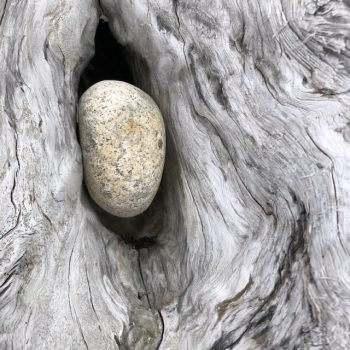 When I refreshed this website, I had big plans for a newsletter. I’m not quite there yet—despite being reassured that I could just pop in a newsletter template, and voila!—it’s not that easy for me and I don’t have the bandwidth at the moment. So, for now, I’ll start here.
When I refreshed this website, I had big plans for a newsletter. I’m not quite there yet—despite being reassured that I could just pop in a newsletter template, and voila!—it’s not that easy for me and I don’t have the bandwidth at the moment. So, for now, I’ll start here.
Why Wrack Line? Because I spend a lot of time on the beach, exploring wrack lines, that place where stuff washes ashore and is deposited. So here, in the very periodic Wrack Line, I’ll track what washes ashore in my brain and what I’d like to remember … and share.
I’ve been loving the newsletter of Lorene Edwards Forkner, an artist and gardener I first heard about through the fabulous podcast, Cultivating Place. I get Lorene’s newsletter, in which she shares her recent art—deceptively “simple” small paintings, colour swatches really, of natural objects that have caught her eye. You can see them on her website, A Handmade Garden, and she’s gathered them in her book, Color In and Out of the Garden.
Not a fan of kale? You know you need to massage it, right? (Seriously, it’s a game changer moving kale from hard-to-digest fibre to delicious, soft, and okay on the gut.) I’ve been doing this for years, but was a bit shocked to get served unmassaged kale at a restaurant the other day, so consider this a PSA.
I loved this short essay by Ann Finkbeiner, “In Praise of the Bean Men.”
But these long-haul people, they find a thing they want to do, that needs doing, that they do well, and they do it for the rest of their lives. We adore our flashing heroes, but these long-haulers we deeply love. I think they seem necessary to our continuance as a society, that human communities are worth the effort. I think they’re necessary to our sense of meaning as humans, that we ourselves are worth the effort. We count on these people, they’re keeping it all going, the only thing stopping them is death.
[Life goal: …find the thing I want to do, that needs doing, that I do well,…]
I knew that January came from the god Janus, but I didn’t make the connection to janitor. Now I have, thanks to another fabulous newsletter, The Whippet. “Two-faced Janus is always looking forward and backward, so he represents points of transition (like doorways), portals and sea ports, beginnings and endings – which is why January is named after him. ‘Janitor’ originally meant doorkeeper rather than cleaner, but you can see how you’d get there via ‘building custodian’.”
Goal for 2023? Follow the Exploding Whale Trail. File that under “what not to do when a whale washes up on the beach.” On that note, though, here is a fascinating video series showing a much better way to deal with a dead whale, from my colleagues at the Hakai Institute. There are several episodes in Whale Bones, but here are the first two: A Whale Washes Up and Cleaning a Carcass.
Secretly love children’s picture books, even though you’re an adult? I say, go for it! The art can be beautiful, the prose heartwarming or nostalgic or just plain silly. I’ll be keeping an eye on Unruly, a new imprint from the published Enchanted Lion. Unruly is “dedicated to making space for picture books created with older readers in mind. … Unruly titles will stand apart as visually complex works of fiction and nonfiction created for older readers. By reframing the readership’s age, Unruly invites a more complex instantiation and exploration of the relationship between text and image, while also inviting consideration of more mature topics.” (Yeah, I had to look up instantiation.)
Do you harbour a dream to work for NASA? Here are 30 citizen science projects you can take part in. (Thanks to Recomendo, for “recomendoing!”)
I make a lot of lists and Umberto Eco says that’s okay. “The list is the origin of culture. It’s part of the history of art and literature. What does culture want? To make infinity comprehensible. It also wants to create order — not always, but often. And how, as a human being, does one face infinity? How does one attempt to grasp the incomprehensible? Through lists, through catalogs, through collections in museums and through encyclopedias and dictionaries.”
Things I’m looking forward to:
Watching: Sarah Polley bringing Miriam Toews’s Women Talking to the screen. Two Canadian women, one captivating—and intense—story.
Drinking: Cranberry Gin Fizz looks like a yummy Christmas cocktail. I’ll might make it a mocktail, by subbing in Lumette alt gin though. I just come for the ginger beer anyhow.
Eating: Vegetarian Tourtière. Yes, I know that’s probably an oxymoron, but it is so good. As made by James Hoyland on the Great Canadian Baking Show and prepared at our place by my husband, which was a feat indeed. So good. On the menu for my upcoming birthday, I think. These labneh balls might make a great appetizer. (I am late coming to labneh, but man it’s good.)
Reading: Remainders of the Day: a Bookshop Diary by Shaun Bythell. I mean, with entries like this, who could resist?
TUESDAY, 1 MARCH
Online orders: 5
Books found: 2My mother appeared at 11 to take Granny out for coffee. Once my mother had left the room, Granny said, “Ha ha, fucking bastard, now you have to do some work,” as she held the shop door open and let the cold wind in to add to my discomfort in her absence.
Here’s a full excerpt from Lit Hub.
End of Wrack Line 1. I think the only way you’d read it is if I told you to (thanks, Margi) or if you happened to follow my website, but thanks for stopping by!
Fake Whale Poop to the Rescue?
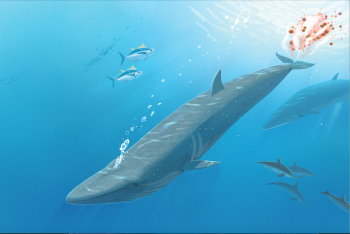
The “poop pump” spread from Whales to the Rescue. Art by Kim Smith.
A few days ago there was an interesting program on the CBC show, The Current, on which the host Matt Galloway interviewed a few scientists with some ideas about how we might buy a bit of time in our race against a warming ocean and atmosphere. (You can see the full transcript here. Just scroll down to “The ambitious science of climate repair.”) I was listening while doing a bit of busy work, but my ears perked up when Galloway introduced Sir David King, director of the Centre for Climate Repair at Cambridge, who discussed seeding the ocean with artificial whale poo. If you’ve read Whales to the Rescue, you’ll know that the role of whale poo and how it can help pull carbon out of the atmosphere is a big part of the book, and a big part of whale baleen whales have a role to play in helping to slow the effects of climate change. Adding artificial whale feces to the ocean is all still experimental, but I’ll follow this with interest. (If you want to read more, here is the link to the “biomass regeneration project“—aka replicating the pooping prowess of the world’s large baleen whales—at the Climate Repair site.)
Here is an article about then project from last spring and here’s a video of an fake whale poo experiment off the Australian coast, called WhaleX.
What do you think? I can’t find much recent news, so things still seem pretty experimental, but I’ll keep following this one.
Anniversary edition of The Sacred Balance
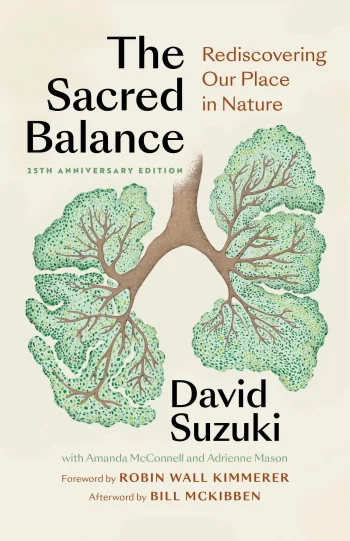
The Sacred Balance, 25th anniversary edition
The 25th anniversary edition of The Sacred Balance: Rediscovering Our Place in Nature by David Suzuki has just been released. I have a small part in this book as I helped edit the third edition back in 2007. (See my name in small print?) I received my updated edition a few weeks ago and I was most excited to see that Robin Wall Kimmerer, who wrote the stellar Braiding Sweetgrass and the less-well-know but also wonderful Gathering Moss, wrote the foreword.
She writes: “Adaptation, the ability to change in such a way that enhances survival and flourishing, occurs not only in the resilience of an individual, but within populations over time. Accumulated changes that increase fitness in a changing world are encoded in genetic libraries and manifest in altered structures, functions and behaviours. Suzuki suggests that restoring the sacred to our our relationship with nature may be the most important adaptation we can make. Here, I think, is the most vital message he carries: that spiritual beliefs and practices, encoded in a worldview, are of immense adaptive value.”
She Steals French Fries by the Seashore
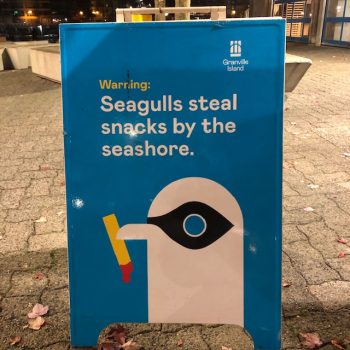
The sneaky bandit gulls of Granville Island.
In this case, she = a gull. (I try to avoid seagull for all sorts of reasons that would probably bore you now. We’ll save that for another day.) One of the friends that came to hang out at the Vancouver Writers Fest came away with more than a few new books—he got a nasty scratch on his cheek by an aggressive gull swooping in to steal his food. Clearly by the look of all of the signs at Granville Island, he’s not alone. This sign was just one of the many on the island.
Gulls are often vilified, but I’d argue they’re just misunderstood. (Aren’t we all?) First, there are many species so we can’t just talk about one kind of gull. (And they don’t all live by the sea, thus “seagull” is problematic.) There are tiny, delicate gulls like the ivory gull I was very fortunate to see swooping above an iceberg in the Arctic, and, sure, there are more thug-like gulls like the glaucous-winged that just happen to be very good at hanging out around people and taking advantage of all of our garbage. (Or, worse, being deliberately fed.) So, yeah, it’s kind of on us. Plus, that’s just showing how smart they are isn’t it? If you’re interested to know more about gulls and why in some places they’re starting to use cities for nesting habitat check out this article I helped edit over at Hakai Magazine.
Vancouver Writers Fest
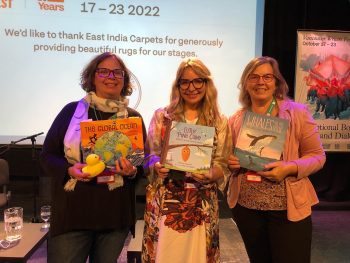
Rochelle, Johanna, and me on stage with our books.
Over the years I’ve attended the Vancouver Writers Festival (even back when I’m pretty sure it was called the Vancouver Writers and Readers Festival), but this year was the first time I’ve been invited to be on stage. I joined fellow writers Rochelle Strauss (with her new book, The Global Ocean) and Johanna Wagstaffe (with her new book, Little Pine Cone) for the event, Oceans and Forests. We chatted to a very excited and energetic audience of young readers—Rochelle and I chatted about the ocean, with my talk being more focussed on the wonders of whale poo and all. Johanna, who is also a meteorologist (you may have seen her on CBC?) had the forest covered and talked about how wildfires affect the natural world in good ways (when we get out of the way) and not so (when we don’t).
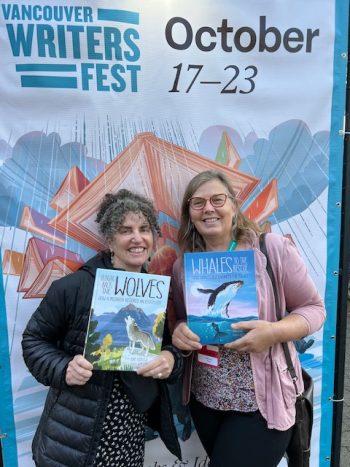
Jude Isabella and me showing off our hard work.
It was a very fun event and we were all buoyed by the enthusiasm of the kids. I only wished we’d stopped talking earlier so we could have answered more of the students’ questions. As it was I think we went over our time by about 30 minutes. Although the audience was mostly students and their teachers, I did have my own little cheering squad of my sister, husband, and two dear friends, including Jude Isabella, author of Bringing Back the Wolves, the first title in Kids Can Press’s Ecosystem Guardians series. (Whales to the Rescue is the second.) We took a moment to show off our books in front of the VWF poster.
10 Things
In the vein of one of my favourite bloggers and “newsletterists,” Austin Kleon, I present you with 10 things about me to get this updated website started!
- I love sardines, kippers, and other little oily fish.
- Given the choice of driving, biking, or walking, I choose walking. At least three or four times a week, I walk on some beautiful west coast beaches.—and I’ve written about two of them, Long Beach and Chesterman—and I hike as often as I can. Moving ones body as it’s meant to do, is critical for someone who has to sit to work. (I did try a walking treadmill in the past, but it didn’t work for me and took up too much space in my small office.)
- I grow vegetables, herbs, and flowers. This year, so many flowers. They bring me great joy, mostly because I’ve grown enough to fill my house with them and to share them with my friends.
- I drive an old Volvo station wagon — a low rider that feels like a tank, yet is good on gas. I treat it as a farm vehicle.
- I am an eclectic and voracious reader. At the moment I have these books on the go: River Thieves by Michael Crummey, Flower Confidential by Amy Stewart, At Home on an Unruly Planet by Madeline Ostrander, Fight Night by Miriam Toews, and Year of Wonder by Clemency Burton-Hill. Why so many? One for my book club, one for the couch in the morning, one for bed, one for work, and one by my desk for when I pay attention to the Post-It note on my computer that says “Fill the well first.” (In other words, give yourself permission to read before you write.)
- I fully embrace the idea of an antilibrary. And because of this, every room in our house safe one (guess which one?) has a bookshelf. Or two.
- I am a serial blogger. Yes, too many, but, for the record, this updated website is a way to reign it all in and get all of my life wrapped up in one URL. If you’re interested though, I have languishing blogs on: my book Long Beach Wild (this one I am trying to “unlanguish” as it generates great memories from readers, but I can’t seem to log in; it’s on my list to resolve); on writing (Tough City Writer); on my art explorations; even gardening. For years I kept a blog called Heart of Tofino, which was all about—yup, Tofino—but I let that go and the URL is gone. It’s too much and too all over the place, but all of that writing is good for honing the craft. It feels good to wrap everything up here though.
- My “handle” for most things social media (well, Twitter and Instagram) is Tough City Writer. It’s not that because I live in a place that is tough or even in a city, but there is a reason. I’ll leave it a bit mysterious for now. Perhaps there is a book prize giveaway in my future?
- I’m all for the underdog—the cracked, the worn, the misunderstood, especially living things we love to hate, or at least grumble about (like spiders or slugs, bogs and rain).
- I care deeply about our planet and how it will be left for my children and, perhaps one day, grandchildren. I’m trying to tread lightly—if you know better, you do better, right?—but I have a lot of learning and work to do.